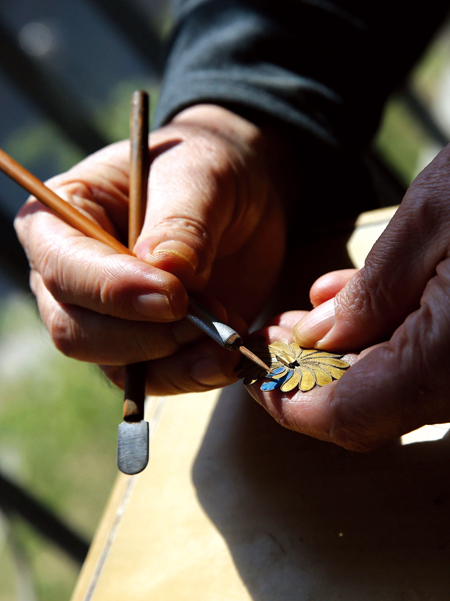 |
|
Dian cui master Xiao Guangchun works on a piece of jewelry. |
"People call the process dian cui, meaning a dipping of blue," he says. "It so perfectly captures the silken texture of the plume, which, under sunlight, seems to melt into a reflective and miraculous pool of indigo."
Not only that, the very term also hints at a dian cui master's light, delicate touch when letting the color flow onto the golden surfaces, one piece of feather at a time. It's a lightness rooted in decades of practice, and rendered possible by a calm, undisturbable state of mind.
"The amount of patience he's shown seems to belong only to a woman, not a man," says Li Dafen, Xiao's wife for nearly 40 years.
Like all artisans who have grown up knowing no god other than the god of his own calling, the 63-year-old Xiao talks fervently about his skills, which is deceptively simple yet punishingly complicated and time-consuming.
"To make sure the feathers stay there firmly and smoothly, for hopefully a hundred years or two, you have to go through a process dictated by strict rules," he says. It's also a process filled with diligently guarded trade secrets. Xiao's skills was passed on to him, exclusively, by his late father, a dian cui master.
"My father personally embodied for me the dying art. And he taught me everything there's to know about it, at a time when the possession of such rare skills could lead to persecution," Xiao says. He is talking about the country's decade-long "cultural revolution" (1966-76), during which everything luxurious was denounced as "immoral".
"My father, who had been doing dian cui since he was 12, was barred from work. In retrospect, what was the greatest pathos for him was a stroke of luck for me, since for the first time, he truly opened up and revealed for me a world behind all the beauty and glitter that met the eye," Xiao says.
| Master strokes | Fresh-faced art |
|
|
|
|
|
|
|
|